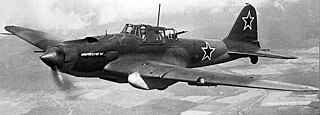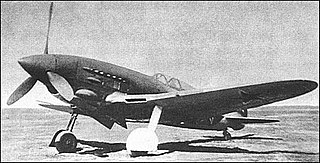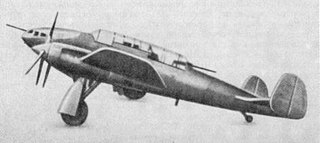
The Ilyushin Il-2 is a ground-attack plane that was produced by the Soviet Union in large numbers during the Second World War. The word shturmovík, the generic Russian term for a ground-attack aircraft, became a synecdoche for the Il-2 in English sources, where it is commonly rendered Shturmovik, Stormovik and Sturmovik.

The Ilyushin Il-10 is a Soviet ground attack aircraft developed at the end of World War II by the Ilyushin construction bureau. It was also license-built in Czechoslovakia by Avia as the Avia B-33.

The Tupolev Tu-14, was a Soviet twinjet light bomber derived from the Tupolev '73', the failed competitor to the Ilyushin Il-28 'Beagle'. It was used as a torpedo bomber by the mine-torpedo regiments of Soviet Naval Aviation between 1952–1959 and exported to the People's Republic of China.

The Yermolayev Yer-2 was a long-range Soviet medium bomber used during World War II. It was developed from the Bartini Stal-7 prototype airliner before the war. It was used to bomb Berlin from airbases in Estonia after Operation Barbarossa began in 1941. Production was terminated in August 1941 to allow the factory to concentrate on building higher-priority Ilyushin Il-2 ground-attack aircraft, but was restarted at the end of 1943 with new, fuel-efficient, Charomskiy ACh-30B aircraft diesel engines.

The Ilyushin Il-6 was a Soviet long-range bomber developed from the Ilyushin Il-4 during 1942. Originally intended as a high-speed replacement for the Il-4, it was recast as a very long-range bomber with fuel-conserving diesel engines before production of the single prototype began in December 1942. Flight testing showed controllability issues when landing at high weights and the engines proved to be hard to start at low temperatures and were slow to respond to throttle movements. Further development was canceled in 1944.

The Ilyushin Il-30 was a Soviet turbojet-powered tactical bomber designed as a higher-performance, swept wing version of the Ilyushin Il-28, in the late 1940s. Its thin wing and engine nacelles necessitated the use of tandem landing gear, the first Soviet aircraft to do so. It was apparently canceled before the prototype made its first flight, although sources disagree with this.

The Polikarpov ITP was a Soviet fighter prototype designed during World War II. Development was prolonged by the evacuation of the design bureau forced by the German advance on Moscow in the fall of 1941. By the time the second prototype was finished the Soviets had fighters with equivalent or better performance already in production and the program was cancelled.

The Petlyakov Pe-3 was the long-range heavy fighter version of the successful Petlyakov Pe-2 high-speed dive bomber used by the Soviet Union during World War II.

The Ilyushin Il-102 was a Soviet experimental jet-powered ground-attack aircraft designed by Ilyushin. Once described as the "most gorgeously ugly combat jet ever," this aircraft was never chosen for production, being surpassed by the Su-25. Only a few development prototypes were built.

The Sukhoi Su-6 was a Soviet ground-attack aircraft developed during World War II. The mixed-power high-altitude interceptor Su-7 was based on the single-seat Su-6 prototype.
The Sukhoi Su-8 or DDBSh was a Soviet prototype ground-attack aircraft of World War II.

The Ilyushin Il-40 was a two-seat Soviet jet-engined armored ground-attack aircraft. The first prototype flew in 1953 and was very successful except when it fired its guns, as their combustion gasses disturbed the airflow into the engines and caused them to flameout or hiccup. Remedying this problem took over a year and involved the radical change of moving the engine air intakes all the way to the very front of the aircraft and repositioning the guns from the tip of the nose to the bottom of the fuselage, just behind the nosewheel. The aircraft, now resembling a double-barreled shotgun from the front, was ordered into production in 1955. Only five production aircraft had been completed before the entire program was canceled in early 1956 when the VVS discarded its close air-support doctrine in favor of tactical nuclear weapons on the battlefield.

The Ilyushin Il-22, USAF/DOD designation Type 10, was the first Soviet jet-engined bomber to fly. It used four Lyulka TR-1 turbojets carried on short horizontal pylons ahead and below the wing. The engines did not meet their designed thrust ratings and their fuel consumption was higher than planned. These problems meant that the aircraft could not reach its required performance and it was cancelled on 22 September 1947.
The Ilyushin Il-46 was a jet-engined bomber produced in the USSR during 1951-2, as the result of a directive to redesign the Il-42 project. The revised specification was for an aircraft with twice the range and 1 1/2 times the bomb load, with a prototype ready to be submitted for state acceptance trials in July 1952. The Ilyushin design bureau set about designing two versions of the same aircraft, the straight-wing (Il-46) and the swept-wing (Il-46S), with as much as possible common to both aircraft. To meet the schedule for state acceptance trials Ilyushin built only the straight-wing version, fearing that the design, manufacture and flying characteristics of the swept-wing aircraft might cause delays.
The Ilyushin Il-8 was a Soviet ground-attack aircraft developed by Ilyushin to replace the Ilyushin Il-2. The first two prototypes were significantly faster than the older aircraft, but proved to be less maneuverable. It was redesigned, incorporating many features of what would become the Ilyushin Il-10, but proved to be inferior to that aircraft in testing. It was not ordered into production.

The Ilyushin Il-16 was a Soviet lightweight armored ground-attack aircraft developed at the end of World War II by the Ilyushin Design Bureau. It was in essence a scaled-down version of the Ilyushin Il-10, but was fitted with a newly developed Mikulin AM-43 engine with the expectation that it would be faster and more maneuverable than its predecessor. However, the engine's defects proved to be impossible to rectify and further development were canceled in mid-1946.

The Polikarpov VIT-1 was a Soviet twin-engined multi-purpose aircraft developed before World War II. One prototype was built in 1937, with an extremely heavy armament for ground attack duties. That was the only example built as it was decided to revise the design with more powerful engines as the VIT-2.

The Polikarpov VIT-2 was a Soviet twin-engined ground attack aircraft developed before World War II. A single prototype was built in 1938 for evaluation purposes. Although a promising design it was recommended that it be introduced into production as a high-speed dive bomber with a reduced armament to increase its speed.
The Ilyushin DB-4 or TsKB-56 was a Soviet twin-engined bomber aircraft of the early 1940s. It was a development of the Ilyushin DB-3 and was intended as a replacement for the earlier aircraft, but only two prototypes were built; engine problems and the need to concentrate production on existing types following the German invasion of the Soviet Union in June 1941 meant that no more examples were built.

The CANSA FC.20 was a twin engine reconnaissance bomber/ground attack monoplane designed and built in Italy in 1941. Several versions with different armament and engines were flown but only the FC.20bis ground attack variant reached squadron service, in very small numbers, before the 1943 armistice.
















